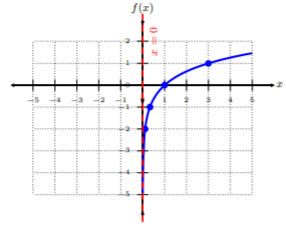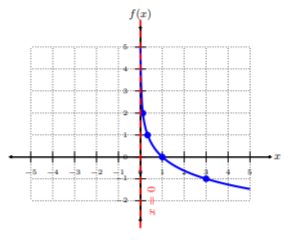12.3: Logarithmic functions
( \newcommand{\kernel}{\mathrm{null}\,}\)
Inverse functions of exponential functions are logarithmic functions, i.e., if we were to compose a logarithmic function with an exponential function (or vice versa) and the result is x((f∘g)(x)=x, then the logarithmic and exponential functions are inverses of each other. The study of logarithms is particularly interesting in many aspects of algebra, and even in advanced algebra, because they are one of the most useful functions. In this section, we introduce logarithms.
The logarithmic function is denoted by
y=logax which is equivalent to x=ay,
where a>0 and a≠1. The base is a,y is the exponent, and x is the value.
The equation y=logax is called the logarithmic form and x=ay is called the exponential form.
When we rewrite equations in logarithmic and exponential form, we can look at the equations in a more general way so that it is obvious where we place parameters:
exponent=logbasevaluewhichisequivalenttovalue=baseexponent
Write in Logarithmic and Exponential Form
Write each exponential equation in its equivalent logarithmic form.
- m3=5
- 72=b
- (23)4=1681
Solution
We first begin to identify the base, exponent and value. Then we rewrite the equation in logarithmic form.
- In the equation m3=5, we identify m is the base, 3 is the exponent, and 5 is the value.
3=logm5whichisequivalentto5=m3 - In the equation 72=b, we identify 7 is the base, 2 is the exponent, and b is the value.
2=log7bwhichisequivalenttob=72 - In the equation (23)4=1681, we identify 23 is the base, 4 is the exponent, and 1681 is the value.
4=log231681whichisequivalentto1681=(23)4
Write each logarithmic equation in its equivalent exponential form
- logx16=2
- log3x=7
- log93=x
Solution
We first begin to identify the base, exponent and value. Then we rewrite the equation in exponential form.
- In the equation logx16=2, we identify x is the base, 2 is the exponent, and 16 is the value.
16=x2whichisequivalentto2=logx16 - In the equation log3x=7, we identify 3 is the base, 7 is the exponent, and x is the value.
x=37whichisequivalentto7=log3x - In the equation log93=x, we identify 9 is the base, x is the exponent, and 3 is the value.
3=9xwhichisequivalenttox=log93
Evaluate Logarithmic Functions
Since logarithms are just exponents, then we can use logarithms to find the exponent, or one of the other parameters, the base or value.
Find the exact value: log5125
Solution
To find the exact value, we refrain from using any technology to obtain the answer and we only use the definition of a logarithmic function. Hence, when we see the expression log5125, we ask, “5 to what power is 125?” because, recall, logarithms are just exponents. Some might already see the answer is 3, but let’s use the definition to present a method for evaluating logarithms. Let log5125=x.
log5125=xRewrite in exponential form5x=125Rewrite using common base 55x=53Common base, equate exponentsx=3Solution
We need to be careful because we introduced x, but x was never part of the original problem. Thus, let’s write the answer properly.
log5125=3
Find the exact value: log3127
Solution
To find the exact value, we refrain from using any technology to obtain the answer and we only use the definition of a logarithmic function. Hence, when we see the expression log3127, we ask, “3 to what power is 127?” because, recall, logarithms are just exponents. Let log3127=x.
log3127=xRewrite in exponential form3x=127Rewrite using common base 33x=133Rewrite using negative exponent −33x=3−3Common base, equate exponentsx=−3Solution
We need to be careful because we introduced x, but x was never part of the original problem. Thus, let’s write the answer properly.
log3127=−3
Domain of Logarithmic Functions
Recall. The domain of a function is the interval of independent values defined for that function.
Hence, it makes sense to discuss the domain of logarithmic functions. With exponential functions, the domain is all real numbers, but let’s see the way it differs from the domain of a logarithmic function.
The domain of the logarithmic function is {x|x>0} or (0,∞), i.e., the value (or argument) of the logarithm is always positive.
Given the logarithmic function f(x)=logax, we can follow the steps below to obtain the domain.
Step 1. Identify the value of the logarithm, x. The value will differ from x as the problems change.
Step 2. Set the value greater than zero, i.e., x>0.
Step 3. Solve the inequality as usual.
Step 4. Rewrite the inequality in interval notation, if needed.
Find the domain of f(x)=log5(2x+3).
Solution
We can follow the steps to obtain the domain of f(x).
Step 1. The value of the given logarithm is (2x+3).
Step 2. Setting the value greater than zero, we get 2x+3>0.
Step 3. Solving the inequality as usual,
2x+3>02x>−3x>−32
This means that all values for x are required to be strictly greater than −32 in order for f(x) to be defined.
Step 4. Rewriting −32 in interval notation, we get (−32,∞).
Thus, the domain of f(x) is {x∣x>−32} or, equivalently, (−32,∞).
Graph Logarithmic Functions
Let’s start to take a look at logarithmic functions by looking at their graphs. Recall, logarithmic and exponential functions are inverses of each other. Hence, we’ll see that their properties also invert, i.e., x and y coordinates switch.
Plot f(x)=log3x by plotting points. From the graph, determine the domain of the function.
Solution
Let’s rewrite the function as y=log3x, and then in its equivalent exponential form: 3y=x. Looking at the exponential form of f(x), we choose to pick y-coordinates, and find corresponding x-values. In choosing y coordinates, we can evaluate the exponential form easily.
| y | 3y=x | (x,f(x)) |
|---|---|---|
| −2 | 3−2=19 | (19,−2) |
| −1 | 3−1=13 | (13,−1) |
| 0 | 30=1 | (1,0) |
| 1 | 31=3 | (3,1) |

Plot the five ordered-pairs from the table. To connect the points, be sure to connect them from smallest x-value to largest x-value, i.e., left to right. Notice this graph is rising left to right, but, as the graph shoots towards 0, it never touches the y-axis or intersects it, resulting in a vertical asymptote, x=0. Since we see there is one restriction to the graph, the domain is all real numbers greater than zero or (0,∞).
Property 1. The domain of an logarithmic function is all real numbers greater than zero, i.e., (0,∞).
Property 2. There are no y-intercepts; the x-intercept is at (1,0).
Property 3. If a>1, then the function is an increasing function. If 0<a<1, then the function is a decreasing function.
Property 4. There is a vertical asymptote at x=0, unless there is a horizontal shift.
A logarithmic function never crosses the y-axis. In fact, the general logarithmic function isn’t defined at x=0. Take a look. If x=0, then f(0)=loga0. Ask, “a to what power is zero?” There exists no such power. We cannot raise a positive real number to a power and the result be zero. In the event a logarithmic function crosses the y-axis, then that means there was a transformation to the general logarithmic function.
Plot f(x)=log1/3x by plotting points. From the graph, determine the domain of the function.
Solution
Let’s rewrite the function as y=log1/3x, and then in its equivalent exponential form: (13)y=x. Looking at the exponential form of f(x), we choose to pick y-coordinates, and find corresponding x-values. In choosing y coordinates, we can evaluate the exponential form easily.
| x | 13y=x | (x,f(x)) |
|---|---|---|
| −1 | (13)−1=3 | (3,−1) |
| 0 | (13)0=1 | (1,0) |
| 1 | (13)1=13 | (13,1) |
| 2 | (13)2=19 | (19,2) |
Plot the five ordered-pairs from the table. To connect the points, be sure to connect them from smallest x-value to largest x-value, i.e., left to right. Notice this graph is falling left to right, but, as the graph shoots towards 0, it never touches the y-axis or intersects it, resulting in a horizontal asymptote at x=0. Since we see there is one restriction to the graph, the domain is all real numbers greater than zero or (0,∞).

This is a good time to mention two very important logarithms: the natural and common logarithm.
- The natural logarithm is given by
y=logex=lnx if and only if x=ey
where e is the irrational number Euler’s constant, e≈2.71828182⋯ Notice the loge is replaced with ln, and that is the only difference. - The common logarithm is given by
y=log10x=logx if and only if x=10y
Notice the log10 is replaced with log, and that is the only difference. When there is no written base on the logarithm, then it is assumed it is the common logarithm (unless it is ln).
Dutch mathematician Adriaan Vlacq published a textbook in 1628 which listed logarithms calculated out from 1 to 100,000.
Solve Logarithmic Equations
Solving equations with logarithms has techniques that are similar when solving exponential equations. We can rewrite the logarithmic equation in its equivalent exponential form and solve.
Solve for x:log5x=2
Solution
We solve the equation by rewriting the equation in its equivalent exponential form and solve.
log5x=2Rewrite in exponential form52=xSimplify25=xSolution
Solve for n:log2(3n+5)=4
Solution
We solve the equation by rewriting the equation in its equivalent exponential form and solve.
log2(3n+5)=4Rewrite in exponential form24=3n+5Simplify 2416=3n+5Isolate the variable term11=3nIsolate n113=nSolution
We can see that the technique is, once the logarithm is isolated on one side of the equation, we can rewrite the equation in its equivalent exponential form and solve.
Solve for t:log(2t−3)=−1
Solution
We solve the equation by rewriting the equation in its equivalent exponential form and solve. First, we see that there is no written base on the logarithm. Hence, we assume this is a common logarithm and the base is ten.
log(2t−3)=−1Write the common logarithm with a base 10log10(2t−3)=−1Rewrite in exponential form10−1=2t−3Simplify 10−1110=2t−3Isolate the variable term3110=2tIsolate t12⋅3110=tSimplify the left side3120=tSolution
Solve for a:lna=4
Solution
We solve the equation by rewriting the equation in its equivalent exponential form and solve. First, we see ln and assume this is a natural logarithm and the base is e.
lna=4Write the natural logarithm with a base elogea=4Rewrite in exponential forme4=aSolution54.598≈aApproximate solution for a
Logarithmic Functions Homework
Rewrite each equation in exponential form.
log981=2
log7149=−2
log13169=2
logba=−16
log16256=2
log111=0
Rewrite each equation in logarithmic form.
80=1
152=225
641/6=2
17−2=1289
1441/2=12
192=361
Find the exact value for each expression.
log1255
log34317
log416
log636
log264
log5125
log71
log4164
log366
log3243
Find the domain of each logarithmic function.
g(x)=log4(7x+10)
h(x)=log3(3x+7)
h(x)=log4(7−8x)
g(x)=log5(4−8x)
Graph each logarithmic function.
f(x)=log4x
g(x)=log1/4x
q(n)=−log2n
h(t)=log1/2t
x(t)=−logt
w(x)=lnx
Solve each equation.
log5x=1
log2x=−2
log11k=2
log9(n+9)=4
log5(−3m)=3
log11(x+5)=−1
log4(6b+4)=0
log5(−10x+4)=4
log2(10−5a)=3
log8k=3
logn=3
log4p=4
log11(x−4)=−1
log2(−8r)=1
ln(−3n)=4
log11(10v+1)=−1
log9(7−6x)=−2
log8(3k−1)=1


